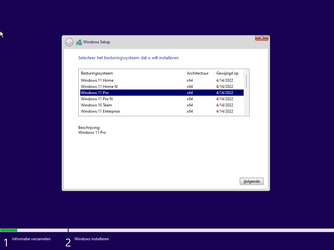Most of you are no doubt aware by now that there are several workarounds to installing Windows 11 on unsupported hardware, if you are willing to take that risk.
If you want to go "whole hog" for example, and install on a non-UEFI based system with no TPM and an unsupported CPU you could do this:
1) Create a registry file that looks like this:
Let's say you save it as "RegUpdates.reg".
2) Place the file on your install media.
3) Boot from the install media. At the first static screen, press SHIFT + F10 to open a command prompt. Run this command:
regedit /s D:\RegUpdates.reg (assumes D: is your boot media)
4) Close the command prompt.
You will now be able to install Win 11 on your unsupported hardware.
But, what if you want to perform an unattended install of Windows 11 on unsupported hardware? Simple. Create your autounattend in the same manner as always.
Add Windows-Setup > RunSynchronous > RunSynchronousCommand to Pass 1 windowsPE in your answer file and set the following values:
Order: 1
Path: regedit /S X:\RegUpdates.reg
NOTE: Don't change the X: in the above path. This is the RAMDrive drive letter Windows uses during setup.
Save the changes to the answer file and save to the root of your Windows install media.
NOTE: The steps below involve editing the BOOT.WIM file. I don't spell out every command to do this because I don't know if anyone other than some nerds like @Kari or myself will even be interested enough to do this. Most likely, if you have read this far, you already know how to do this. If you need detailed steps, let me know and I would be happy to provide those.
Mount the \sources\boot.wim file from the Windows image file. Note that you want to target index 2.
Drop the RegUpdates.reg file in the root of the mounted image.
Save and unmount the boot.wim.
Replace the boot.wim in the original image with the updated boot.wim.
Re-burn your ISO image or create your boot media. The registry change will automatically be applied within Windows PE and Windows 11 should be able to install on your unsupported hardware.
NOTE: Because this registry change takes place only in the running instance of Windows PE, it won't make any changes to your actual Windows installation. No change is needed there anyway. It is only setup (run within WinPE) that cares about this.
If you want to go "whole hog" for example, and install on a non-UEFI based system with no TPM and an unsupported CPU you could do this:
1) Create a registry file that looks like this:
Code:
Windows Registry Editor Version 5.00
[HKEY_LOCAL_MACHINE\SYSTEM\Setup\LabConfig]
"BypassTPMCheck"=dword:00000001
"BypassSecureBootCheck"=dword:00000001
"BypassRAMCheck"=dword:00000001
"BypassStorageCheck"=dword:00000001
"BypassCPUCheck"=dword:00000001Let's say you save it as "RegUpdates.reg".
2) Place the file on your install media.
3) Boot from the install media. At the first static screen, press SHIFT + F10 to open a command prompt. Run this command:
regedit /s D:\RegUpdates.reg (assumes D: is your boot media)
4) Close the command prompt.
You will now be able to install Win 11 on your unsupported hardware.
But, what if you want to perform an unattended install of Windows 11 on unsupported hardware? Simple. Create your autounattend in the same manner as always.
Add Windows-Setup > RunSynchronous > RunSynchronousCommand to Pass 1 windowsPE in your answer file and set the following values:
Order: 1
Path: regedit /S X:\RegUpdates.reg
NOTE: Don't change the X: in the above path. This is the RAMDrive drive letter Windows uses during setup.
Save the changes to the answer file and save to the root of your Windows install media.
NOTE: The steps below involve editing the BOOT.WIM file. I don't spell out every command to do this because I don't know if anyone other than some nerds like @Kari or myself will even be interested enough to do this. Most likely, if you have read this far, you already know how to do this. If you need detailed steps, let me know and I would be happy to provide those.
Mount the \sources\boot.wim file from the Windows image file. Note that you want to target index 2.
Drop the RegUpdates.reg file in the root of the mounted image.
Save and unmount the boot.wim.
Replace the boot.wim in the original image with the updated boot.wim.
Re-burn your ISO image or create your boot media. The registry change will automatically be applied within Windows PE and Windows 11 should be able to install on your unsupported hardware.
NOTE: Because this registry change takes place only in the running instance of Windows PE, it won't make any changes to your actual Windows installation. No change is needed there anyway. It is only setup (run within WinPE) that cares about this.
My Computers
System One System Two
-
- OS
- Win11 Pro 24H2
- Computer type
- PC/Desktop
- Manufacturer/Model
- Self-built
- CPU
- Intel i7 11700K
- Motherboard
- ASUS Prime Z590-A MB
- Memory
- 64GB (Waiting for warranty replacement of another 64GB for 128GB total)
- Graphics Card(s)
- No GPU - Built-in Intel Graphics
- Sound Card
- Integrated
- Monitor(s) Displays
- HP Envy 32
- Screen Resolution
- 2560 x 1440
- Hard Drives
- 1 x 1TB NVMe SSD
1 x 2TB NVMe SSD
1 x 4TB NVMe SSD
3 x 512GB 2.5" SSD
1 x 4TB 2.5" SSD
5 x 8TB Seagate Barracuda HDD
- PSU
- Corsair HX850i
- Case
- Corsair iCUE RGB 5000X mid tower case
- Cooling
- Noctua NF-S12A chromax.black.swap case fans (Qty. 7) & Home Computer Specifications, Configuration, and Usage Notes General Specifications ASUS Prime Z590-A motherboard, serial number M1M0KC222467ARP Intel Core i7-11700K CPU (11th Gen Rocket Lake / LGA 1200 Socket) 128GB Crucial Ballistix RGB DDR4 3200 MHz DRAM (4 x 32GB) Corsair iCUE RGB 5000X mid tower case Noctua NH-D15 chromax.black CPU cooler Noctua NF-S12A chromax.black.swap case fans (Qty. 7) & Corsair LL-120 RGB Fans (Qty. 3)
- Keyboard
- Corsair K70 Max RGB Magnetic Keyboard
- Mouse
- Logitech MX Master 3
- Internet Speed
- 1Gb Up / 1 Gb Down
- Browser
- Edge
- Antivirus
- Windows Defender
- Other Info
- The five 8TB drives and three 512GB SSDs are part of a DrivePool using StableBit DrivePool software. The three SSDs are devoted purely to caching for the 8TB drives. All of the important data is stored in triplicate so that I can withstand simultaneous failure of 2 disks.
Networking: 2.5Gbps Ethernet and WiFi 6e
-
- Operating System
- Win11 Pro 23H2
- Computer type
- Laptop
- Manufacturer/Model
- Lenovo ThinkBook 13x Gen 2
- CPU
- Intel i7-1255U
- Memory
- 16 GB
- Graphics card(s)
- Intel Iris Xe Graphics
- Sound Card
- Realtek® ALC3306-CG codec
- Monitor(s) Displays
- 13.3-inch IPS Display
- Screen Resolution
- WQXGA (2560 x 1600)
- Hard Drives
- 2 TB 4 x 4 NVMe SSD
- PSU
- USB-C / Thunderbolt 4 Power / Charging
- Mouse
- Buttonless Glass Precision Touchpad
- Keyboard
- Backlit, spill resistant keyboard
- Internet Speed
- 1Gb Up / 1Gb Down
- Browser
- Edge
- Antivirus
- Windows Defender
- Other Info
- WiFi 6e / Bluetooth 5.1 / Facial Recognition / Fingerprint Sensor / ToF (Time of Flight) Human Presence Sensor










